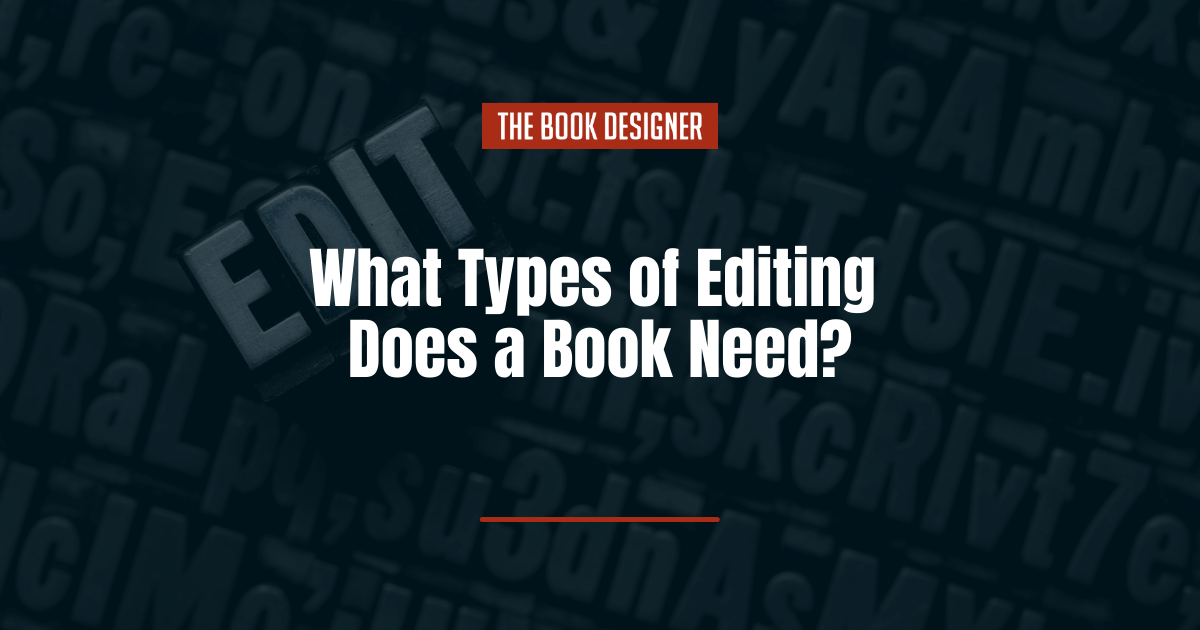As a writer, you’re likely well-acquainted with the adage: all writing is rewriting. The process entails crafting an initial draft from an idea and then undergoing multiple rounds of different types of editing to refine every word. While this journey might be time-consuming, the impact your writing has on readers makes it undeniably worthwhile.
By gaining a thorough grasp of the various types of editing and pinpointing which one you need at each step of the writing and publishing process, you can save both time and effort. Moreover, this understanding will empower you to enhance your book in ways tailored to its specific requirements, elevating it from good enough to exceptional.
Remember, the core principle remains unchanged: all writing is rewriting. However, the realm of rewriting is multifaceted, with distinct types each focusing on a different facet of your story. The decision on which editing route to take hinges on factors like your writing’s purpose, your target audience, and the essence of your content. Making the right choice will undoubtedly shape the trajectory of your work for the better.
In this article, we’ll cover:
Why Are There Different Types of Editing?
Just as there are different types of workouts to target specific health goals, there are different types of editing to target different writing goals.
To continue with the workout example, let’s say you’ve been working out for several years and feel you’ve plateaued. If you’ve done the same workout every day for quite awhile, you may want to consider a different workout.
At this point in your health and fitness journey, you may reach out to a personal trainer or join a fitness class. These options will provide you with different workouts to choose from, based on your specific goals.
If your goal is to gain muscle mass, you’ll likely take part in different workouts than if your goal is to lose overall body weight.
The same is true for writing.
Let’s say you’re writing a YA fantasy book and you’ve finished telling your entire story in just 30,000 words. That’s definitely on the short side for a YA novel, especially if it’s fantasy (many YA fantasy novels exceed 100,000 words). Or maybe you’re having the opposite problem: you’re only 3/4 of the way through your story and you’ve already hit 200,000 words. While there are definitely some novels out there with that kind of word count, publishing them in print can be financially challenging.
This is where you need to know which type of editing would benefit your particular situation. One type of editing will help you dive into developing characters and worldbuilding (adding words) while a different type of editing will help you cut unnecessary scenes and therefore cut your word count.
So, let’s talk about editing specifics.

Developmental Editing
Developmental editing, a critical part of the revision process, centers on improving the manuscript as a whole. It addresses major elements such as the plot and character development. During this phase, the editor collaborates with the writer, providing notes to guide improvements.
Typically, a developmental editor identifies areas for enhancement or issues within the manuscript. In fiction, they may identify things like plot holes or inconsistencies in your worldbuilding. In nonfiction, they may identify knowledge gaps the reader is likely to have or consider different ways to arrange your content for the most impact.
A developmental editor may suggest a host of changes to your manuscript, including structural changes. Imagine an editor receiving a lengthy fiction manuscript for copyediting. After noticing trouble spots like a muddled plot and indistinct characters, the editor takes an unconventional approach. She prints out problematic sections and reassembles them, ensuring a natural flow that aligns with reader expectations.
Substantive Editing
Substantive editing deals with organizing and presenting existing content. It involves rewriting to enhance style, eliminate ambiguity, reorganize disorganized sections, and adjust tables, among other forms of remedial editing.
Think of substantive editing as crafting a well-structured how-to guide. It’s not quite as “big picture” as developmental editing, and often takes place later in the writing process, but it’s a step above line editing.
Line and Sentence-Level Editing
Line editing (sometimes also called style editing) entails a comprehensive review of the manuscript, focusing on every line. It examines the arrangement of words within sentences, the impact of sentences, the strength of dialogue, and more. Line editing enhances the overall flow and power of your prose.
Sentence-level editing, referred to as copyediting, addresses grammar, usage, and consistency issues. Copyediting also tackles continuity errors introduced during revisions, ensuring a polished and error-free final product.
Manuscript Proofreading
Proofreading is vital before a work is published. It ensures that all grammatical and spelling errors are corrected. Proofreading is sometimes combined with copyediting, although some authors opt to employ two separate people for these tasks.
While it’s nearly impossible to eliminate every single error in a manuscript (how many books from major trade publishers have you found a typo in?), a good proofreader will catch 99.99% of mistakes and make sure that the work really shines.
Mechanical Editing
Mechanical editing, as per the Chicago Manual of Style, 17th Edition, involves consistently applying a particular style to a work, including text, documentation, tables, and illustrations. It also addresses grammar, syntax, and usage.
Especially for nonfiction works, mechanical editing proves invaluable. While crafting exceptional copy is vital, the layout’s overall quality is equally crucial. Mechanical editing ensures that the book’s format complements the content instead of diverting attention from it.
Good mechanical editing also speeds up the book formatting process. When consistent styles are used throughout the work, formatters can automate much of the formatting process by simply changing the specifics of each style. For example, if every chapter title is formatted using the “title” style, then a formatter can change all of them simultaneously just by updating that style.
Proof Editing
Proof editing, or proofing (not to be confused with proofreading), is the final stage of editing and involves the finalized copy of the book’s proof, either in digital or hard copy format. It’s the last chance to rectify any issues before the book goes to print.
A proof editor meticulously examines format, spelling, grammar, and consistency. Fresh eyes are vital for spotting typos and other overlooked errors. Some authors do their own proof editing, but it can be valuable to hire someone to do it for you, especially if you’re doing a run of offset printed books.
What Kind of Editing Do I Need?
Typically, a manuscript will travel more or less through the first four levels of editing mentioned above before it’s deemed polished and ready for the reader. But that doesn’t mean that you’ll need to hire an editor for each kind of editing.
What your book needs depends on your strengths as a writer.
If you’re brilliant at outlining a book in a clear and logical way, or if you’re a master at crafting the perfect plot or story arc, you won’t necessarily need a developmental edit. If you struggle with explaining yourself clearly, or crafting realistic dialogue, your editor might recommend a structural or line edit.
At the very least, every manuscript will benefit from a sentence-level edit, or a copyedit. If your editing budget is limited, you can be strategic about the services you select. You can also use various tools to do a certain amount of self-editing.
Regardless of what your manuscript needs, working with an editor can help you improve your writing—particularly if you approach the process with a willingness to learn about your writing quirks (we all have them). With a positive and open attitude, you’ll not only get a better book, you’ll save money on your next editing project with what you’ve learned from this one.
What to Send an Editor
So you’ve determined which types of editing you need and have found a few editors you think might be the right fit for your book. How do you go about actually hiring an editor?
To get a quote from an editor, it’s a good idea to send them a 10-page sample from the “messy middle” of your manuscript. In other words, don’t send them the first 10 pages, which you’ve likely already gone over with a fine toothed comb. Instead, send them a random chapter from somewhere in the middle of the book, something you likely haven’t spent as much time on. This will give them a realistic picture of what your manuscript actually looks like and what kind of time will be involved in editing it.
If you’re hiring an editor for a novel, you may want to also send them a synopsis of the plot. If you’re writing nonfiction, the table of contents is likely sufficient. Of course, be sure to check an editor’s website to see if they have specific questions or requirements for getting a quote.
Takeaways
Not every book will need every type of editing listed here. For example, you may be able to use beta readers for much of your developmental or substantive editing, and then just hire a pro to do a line edit for you. There are self-published authors out there who skip professional editing all together (some are even super successful), but one of the most common complaints you’ll see in their less-than-favorable reviews are comments about typos or grammatical errors. That’s why it’s important to understand where your strengths and weaknesses lie, and to hire a pro to make up for your potential shortcomings.
Editor’s note: This article was updated in 2023 to be more comprehensive and combines elements from articles by Sarah Rexford, Corina Koch MacLeod, and Carla Douglas.



